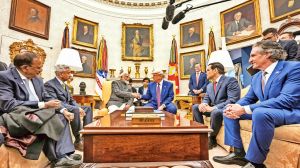Fare hike likely to have pushed Metro ridership to 4-year low, shows data
Currently, Delhi Metro’s total network length has crossed the 250-km mark, but the fare hike seems to have forced lakhs of commuters to stop using the signature public transport of one of the world’s most polluted cities.
 The last time the Metro ridership was this low was in 2013-14 and 2014-15 when the average daily ridership were around 22 lakh and 24 lakh respectively.
The last time the Metro ridership was this low was in 2013-14 and 2014-15 when the average daily ridership were around 22 lakh and 24 lakh respectively.
Last October’s tariff hike appears to have dragged Delhi Metro’s daily average ridership to pre-2015 levels, when trains ran on fewer corridors, spanning around 190 km in length, The Indian Express has learnt. Currently, Delhi Metro’s total network length has crossed the 250-km mark, but the fare hike seems to have forced lakhs of commuters to stop using the signature public transport of one of the world’s most polluted cities.
According to records with the Delhi government, the average daily ridership in the months following the fare hike has dropped by up to 15 per cent as opposed to the previous months.
In the months of October 2017, November 2017, December 2017 and January 2018, an average of 24.2, 24.5 lakh, 22.97 lakh and 23.23 lakh people commuted daily on Yellow Line, Blue Line, Red Line, Green Line and Violet Line collectively. In February, the figure improved marginally to 24.06 lakh. During the first two weeks of March, the average daily ridership has been 20.11 lakh.

The rapid mass transit lost over 2.6 lakh commuters per day last November, 4.23 lakh daily last December, 3.9 lakh commuters daily in January and 3.14 lakh commuters per day in February. The last time the Metro recorded a ridership of 30 lakh was in October 10, 2017, the day Metro’s second phase of fare hike kicked in. The first phase of the hike came into effect in May.
The last time the Metro ridership was this low was in 2013-14 and 2014-15 when the average daily ridership were around 22 lakh and 24 lakh respectively. In 2015-16, it rose to 25.9 lakh, and in 2016-17, it increased further to 27.6 lakh. Till May 2017, Metro transported around 28 lakh passengers daily. Since then, it has largely been a downhill ride. October’s hike bled Metro even further in terms of commuters.
On Wednesday, during the launch of the Pink Line, Chief Minister Arvind Kejriwal had appealed to the Centre to reduce the commuting fares. However, Union Minister Hardeep Puri made it clear that no such rollback was possible.
In a statement, DMRC said that ridership has been going up again since January. “About 24,000 more commuters travelled by the Metro every day in January in comparison to December, 2017. In February, 2018, there was an increase of over 30,000 riders every day. Therefore, the trends for the last two months indicate that ridership is on a upward trend,” the statement said. “The highest ridership achieved in December, 2017, was 25.64 lakhs while in January, 2018, the same figure stood at 26.85 lakhs. The highest ridership in February has been even higher at 26.98 lakhs. Metro’s ridership is generally low in the months of December and January every year because of the holiday season. The same trend could be observed this year also. However, despite the holiday season, January registered a better ridership than the preceding month,” the statement added.
However, if one goes by the ridership trends, such monthly variations are usual and DMRC has a lot of ground to cover if it is to attain ridership levels (discounting the commutership on the corridors such as Magenta Line and Pink Line which were launched after the fare hike) recorded just before the tariff hike.
Last year, in July, August and September, the Metro’s daily average ridership figures were 26.9 lakh, 28.5 lakh and 28.4 lakh, respectively, reflecting a trajectory of sustained growth
Last year, the DMRC had increased its fares twice — in May and October. The current fare structure is: up to 2 km — Rs 10, 2 to 5 km — Rs 20, 5 to 12 km —Rs 30, 12 to 21 km — Rs 40, 21 to 32 km — Rs 50, and for journeys beyond 32 km — Rs 60 .












